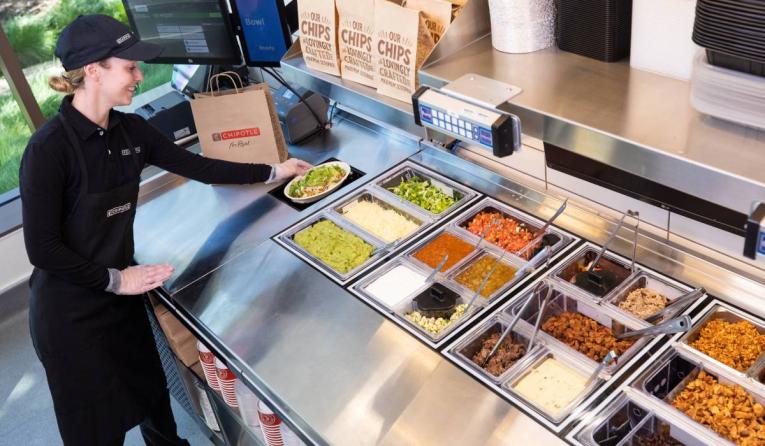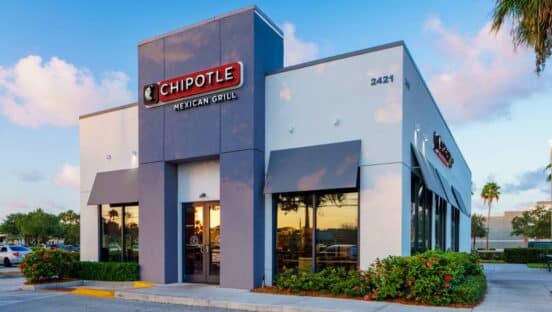You could say Chipotle had an enviable problem. The brand’s digital growth out of COVID soared rewards membership over 35 million and loaded up the backline to the point where stores became unbalanced in staffing. In the summer of 2022 or so, Chipotle launched what it dubbed “Project Square One.” As it sounds, the notion was to return to basics on the in-store experience that helped Chipotle define a category over three decades ago.
Running through the middle of this initiative was an age-old tactic that, admittedly, had gotten overwhelmed by Chipotle’s off-premises expansion in recent years: throughput.
The brand historically had three crew members on the front-line during peak. Chipotle recognized it needed four. The latter employee, often the expediter, was leaving the front far too often to help the digital line. That employee had to stick to in-store orders, bring together items, and communicate them to the cashier. “Alleviating this bottleneck is critical for delivering great throughput,” CEO Brian Niccol said in July.
The good news, though, was Chipotle wasn’t in search of consumer demand. It had more business flowing through more channels than ever, with restaurants opening at a faster clip than any point in company history. So Niccol saw the upside. Chipotle just had to get faster.
That came into focus in Q4 and across 2023, the brand shared Tuesday afternoon in what BTIG analyst Peter Saleh called “one of the most impressive quarters that Chipotle has posted in several years.” Sharon Zackfia, head of William Blair’s equity research consumer group, added a plausible scenario now exists for the fast casual to nearly triple its annual revenue and more than triple its operating profit to $28 billion and north of $5.5 billion, respectively, over the next decade. “Chipotle upped the ante again,” she said.
The brand posted same-store sales growth of 8.4 percent amid what’s been a somewhat choppy earnings season thus far for restaurants. But the main outlier was 7.4 percent transaction growth, which accelerated from mid-single digits in October and 4 percent-plus in Q3. Niccol said growth stemmed from all income demographics, including the lower-level threshold that’s proven so elusive recently for peers. Average ticket rose 1 percent on about 2.5 percent price, partly offset by 1.5 percent of unfavorable mix on smaller group size and lesser add-on attach rates as on-premises growth outpaces digital. Or, put differently, customers are dining in Chipotle restaurants once again.
And to that point, the company’s directive two years ago to refocus that elemental part of its business arrived ahead of the flood. In the last couple of quarters in particular, Chipotle put building blocks in place, Niccol said, to deliver throughput at scale. It adjusted the cadence of orders on the digital makeline to achieve a better balance of labor.
Additionally, Chipotle started to collect data on the execution of throughput pillars and provide feedback and coaching on a weekly basis. Niccol said this allowed teams to see progress. In some respects, the concept gamified execution. And lastly, employees now have real-time access to their “max 15” throughput results. So GMs (turnover is down here into the low 20 percent range) can coach and recognize success as it’s happening, or course correct.
Since implementing these tools in Q3, Niccol said, Chipotle observed the number of restaurants with at least four crew members on the front line during peak periods improve from 30 to 50 percent.
That drove an acceleration in throughput performance as the number of entrees in Chipotle’s peak 15 minutes lifted by a full point in Q4 compared to last year.
There are other factors mixed in, but this improvement can’t be understated in the store-by-store equation. Chipotle reached another watermark in Q4—average-unit volumes over $3 million, the highest in brand history. Alongside the rapid rollout of its order-ahead “Chipotlanes,” of which there are now 811, or 24 percent of units from 2019 to now, Niccol said he felt confident Chipotle would reach $4 million AUVs as it runs toward 7,000 locations. That scenario implies about a 3 percent annual increase in AUVs over a decade—“easily credible for a concept that achieved comp growth of 8 percent in both 2022 and 2023, the latter inclusive of accelerating traffic throughout the year,” Zackfia said.
Chipotle opened 121 restaurants in Q4—the most it’s ever put down—and 271 for the year, also an unprecedented result. Of those 271, 238 included a Chipotlane and the brand expects 80 percent of its 2024 plan (285–315 new restaurant openings) to feature the channel. Chipotle ended 2023 with 3,437 units as revenue reached $9.9 billion, an increase of 13.4 percent versus 2022. Across the full fiscal calendar, comps climbed 7.9 percent on transaction growth of 5 percent and average check lift of 2.9 percent. Digital sales reached 47.4 percent of F&B revenue. Restaurant margin expanded 140 basis points to 25.4 percent.
But again, management reiterated often Tuesday (the word was mentioned 25 times) the role throughput played in harnessing the surge. Niccol noted crew turnover was in the low 100 percent range—a mammoth improvement from the nearly 200 percent levels seen over recent years. “We expect the number of fully staffed locations to increase through 2024 and drive continued improvements in speed of service,” Saleh said.
Niccol said getting to $4 million AUVs is an execution and people game for Chipotle. “I think we’re very fortunate that it doesn’t require another daypart,” he said. “It doesn’t require something that we aren’t currently doing today to achieve that result.”
There are some flashy fixes in the works, too. Chipotle’s “Cultivate Next Fund” launched two years ago in hopes of getting the brand on the ground level of some early stage platforms. Niccol said the company reviewed “hundreds of innovative companies.” Two that emerged were Hyphen and Autocado, both of which are designed to improve employee experience by automating less favorable tasks. Chipotle plans to pilot the make line (hyphen) and the robot that peels and cores avocados in a restaurant this year.
“But one thing I think that we demonstrated this last quarter is when we perform better on the operation front all those things … I would call it almost a multiplying effect,” Niccol said. “So the good news is we still have a lot of headroom to go on operational execution, and I think we’ve got the right things in place for the long term to get us to that $4 million and beyond.”
He noted Chipotle increased the aforementioned “max 15” each month throughout 2023 and witnessed some of its best results in December. Those trends flowed into January. The brand is still working on making sure line members are in position to deliver, but one thing that’s solidified, Niccol explained, is restaurants aren’t confused on what matters most. “I get to visit restaurants [and it’s] the first thing that’s on people’s minds. How are we doing on throughput?” he said. “How are we doing on culinary? And how are we doing with the people and culture? So it’s nice to see.”
“The thing I love is that the teams are laser focused on getting after it,” Niccol said earlier. “I think we’ve now given them more tools that they have better visibility on how they’re performing real time.”
Prep in the morning is a critical piece of this puzzle as well. Generally, if Chipotle takes care of that, lunch cruises. Autocado and other robotics to help cut onions and jalapenos, for example, would be “huge enablers,” Niccol said.
“That’s why you continue to see us look at all these robotic ideas to make prep even more efficient,” he said. “One thing I know for sure is if we could get every restaurant 100 percent of the time to have their prep done on time and ready to roll, our throughput would go up.”

Other trends (digital mostly) at work
As Chipotle continues to strengthen in-store, whitespace remains on the topic of digital expansion. The brand improved its app throughout 2023, including order readiness messaging, wrong location detection, reminders to scan for points at check out, and prior-order history. It also launched “Freepotle” drops for rewards members, which bumped engagement and enrolled new users, Niccol said, as Chipotle was able to surprise guests with free guac, beverages, and double meat.
Through this program, the chain learned more about its ballooning base and how it can deliver more relevant experiences, he added. And Chipotle then rolled suggestive upsell on its app at checkout based on data collected, including what guests ordered in the past.
Chipotle’s incidence of sides has grown steadily in recent quarters, partly thanks to this feature and other digital efforts, like rewards communication. “Historically, you get a Mexican Coke with your order,” Niccol said, offering an example. “When you get to check out it, if you don’t have Mexican Coke in your basket, we will serve you a suggestive sell of, ‘hey, you forgot your Mexican Coke.’ Versus before, we might have just been saying, ‘hey, maybe you should think about chips and queso.’ So what we’re seeing is that type of insight into the individual results in more commercialization or higher check as they check out, because we’re serving a lot of things that they historically have usually added to their ticket.”
It’s also helped that Chipotle made stocking up on sides late in shifts a priority. This, like throughput, pulsed as a growth opportunity six to nine months ago. The notion of simply not running out of items guests want to order.
“Our teams are very aware that they should be ready to go with those side items. And I think as a result, you’re seeing more people attach them,” Niccol said. “We aren’t doing anything out of the ordinary other than making sure we’ve got great product ready to go. And when people know it’s there, they order it.
Niccol said Chipotle is on a multiyear path to “commercializing our customer data and insights into more targeted marketing campaigns.” Ultimately, an improved digital experience will lead to frequency and higher spend.
CFO Jack Hartung also briefly touched on the upcoming California wage bump to $20, set to take shape in April. Pricing across the brand will be in the 2.5–3 percent range in Q1, but Chipotle hasn’t made a final call yet on how high the number will climb in the Golden State. “We’ll wait and see just what the landscape looks like, what the consumer sentiment is, what other companies are going to do,” Hartung said. “So I would say in terms of the impact, California represents about 15 percent of our restaurants. So depending on where we end up, there’d probably be an extra 80-ish, 90-ish basis point to maybe something over 100 basis point in terms of additional menu price across all of our 3,400 restaurants just to give you kind of an order of magnitude.”







